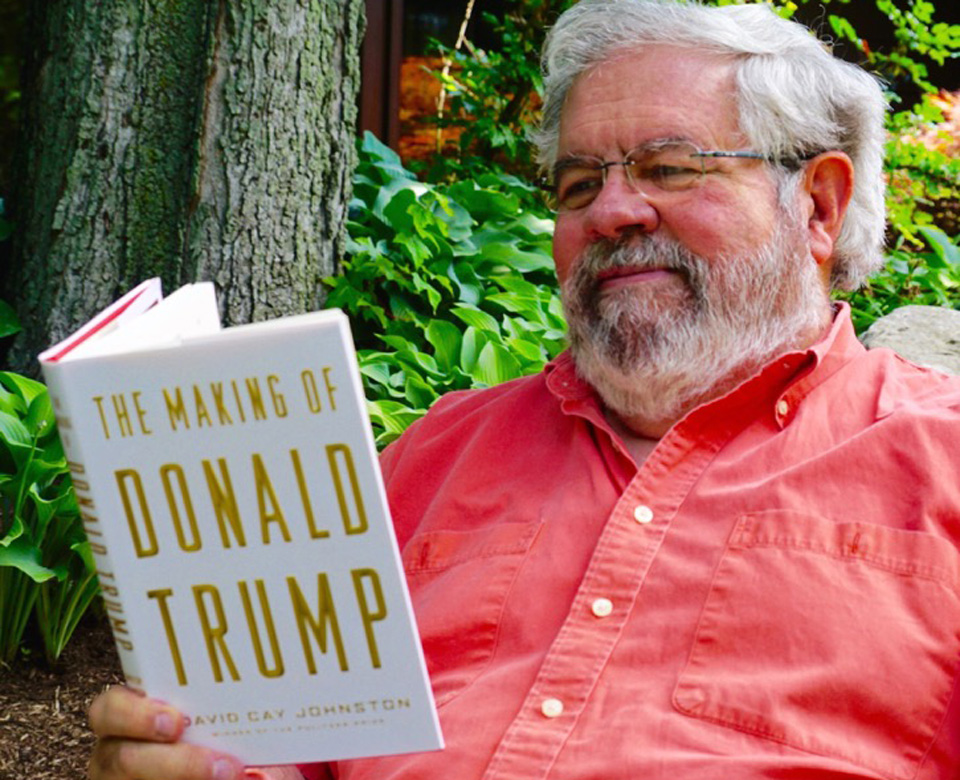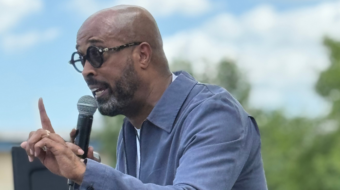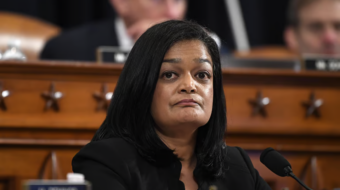
Much has been made about how the Republican contender for the White House frequently changes positions and the way Trump on the stump is vague about policies. What is one to make of The Donald-who-would-be-president? Pulitzer Prize-winner David Cay Johnston’s new book, The Making of Donald Trump (Melville House Publishing), sheds light on how the real estate baron/reality TV star really operates. In a recent interview, the investigative reporter, who has known and been covering Trump since 1988, described his 263-page tome as “essentially everything in the public record that Trump does not want you to know.”
Among those things is the sound and fury that surrounded Trump International Hotel and Tower at Waikiki Beach Walk, which in 2006 the Pacific Business News (PBN) called “Trump’s first venture in Hawaii.” In The Making of Donald Trump Johnston covers the dispute over this project and the role — or lack of one — Trump played in it. This is a cautionary tale that may provide insight into how Trump might govern if he convinces the electorate on Nov. 8th to provide him with America’s most coveted property: 1600 Pennsylvania Avenue.
“The very definition of the American success story”
It was announced in early 2006 that Trump Waikiki — a 38-story luxury hotel-condominium tower with units priced $500,000 to more than $5 million each — was being built at 223 Saratoga Road (and Kalia), which was touted as “Waikiki’s most prominent address.” (It is not actually an ocean front property.) Trump Waikiki was to be designed in “tropical deco style” with “koa wood” and “tapa” and would, according to Trump, set “a new standard for luxury in Waikiki.”
The project team included the Los Angeles-based real estate investment and development firm Irongate; S&P Destination Properties; various architects; and others, including, significantly, Donald J. Trump, whose sheer magnificence and beatitude were oft-trumpeted in PR literature as Manhattan’s Prince Charming of real estate and an “internationally renowned developer” who “is the very definition of the American success story.”
Involvement of this celebrity brought star power, glitz and attention to Trump Waikiki. The razzle-dazzle bestowed by the aura of The Apprentice’s host helped trigger a feeding frenzy. According to a Nov. 10, 2006, press release by Honolulu-based Communications Pacific: “On Thursday, November 9…[Trump Waikiki]…set a record for the amount of residential property (dollar and unit volume) sold in one development in a single day…. The over $700 million (US) sale is the biggest one0day sale in real estate history in the world. By the end of the first day…100 percent of the 464 hotel suites and residences were sold,” to a variety of buyers from Hawaii, the Continental U.S., Japan, etc.
The ballyhooing added, “S&P President Sid Landolt stated: ‘We’ve seldom seen such a positive response to a luxury condo with as many people excited about it…. It’s a testament to the high quality of the project, the strength of the Trump brand…high net worth investors in Japan are embracing…the Trump name for quality and investment value.’”
What’s in a name?
In a phone interview with David Cay Johnston in New York, he asserted: “Trump promoted this project…at Waikiki as a Trump development. And as with many other projects he referred to himself as the ‘developer’ or the ‘builder.’ In fact, all he did was license his name to be on the building.”
As Juliet asked in Shakespeare’s tragedy about star-crossed lovers: “What’s in a name?” It turns out that when it comes to branding and property prices, quite a lot is at stake. By 2009 some purchasers began ruing their Trump Waikiki investments, suspecting — to paraphrase Romeo and Juliet — that this “rose by any other name would not smell as sweet” — and litigation started blooming in connection to this star-crossed property.
Johnston continued, “After people bought into this building they made a rather disturbing discovery: The name was not permanent. Trump could remove it, he could demand future payments. In fact, he could remove his name and put it on a building right next door. So if you paid a premium price because you thought the name Trump justified that as an investment, you were actually at a great deal of risk.”
In 1987, Hawaii Gov. John Waihee appointed Warren Price state attorney general; in 1992 he joined the Honolulu law firm Price Okamoto Himeno & Lum. Price went on to represent Trump Waikiki investors, including, according to a July 13, 2009, PBN article, “six Hawaii couples, two doctors from San Diego, the head of a California meat exporting business and a professional basketball player from New Orleans…. ‘These people were investing in a Rolls Royce. They were told it could magically turn into a Ford,’ said attorney Warren Price….” According to Associated Press, Irongate, not Trump, was named as the defendant in the lawsuit.
On July 14, 2009 the then-Honolulu Advertiser reported: “Price said his clients aren’t suffering from buyer’s remorse, but are worried that Trump may terminate Irongate’s license to use his name on the project, diminishing the value of their investments. Details over how Trump or Irongate can terminate the license agreement were not disclosed to buyers, he said.”
Shortly after Price filed his suit in Honolulu circuit court, Honolulu attorney John Perkin filed a separate lawsuit on behalf of other plaintiffs in federal court, alleging “promotional material for Trump Waikiki stated that buyers could ‘obtain optimum rental income and occupancy’ through the hotel owner’s management of their apartment units.”
PBN reported July 21, 2009 that Irongate countersued the Price plaintiffs in circuit court, contending they’d lodged a “sham lawsuit brought without any objective merit or probable cause and is part of the defendants’ broader plan to attempt to harm and devalue the project.”
Waikiki’s not-so great Gatsby
Johnston said Trump Waikiki “was completed; Trump’s name is still on it. There are a lot of people who got wiped out and lost money on it. The Trump Waikiki project is not some aberration. There were projects in Baja California, Tampa, Fort Lauderdale, and complaints by investors about the Trump Soho in New York. And in some of these projects — the ones in Florida and the Soho — Donald Trump’s partners included Felix Sater, but it was hidden from both anchors and investors that he was a violent, convicted felon who ran a stock swindle. That’s pretty serious.”
In The Making of Donald Trump (containing 44 pages of endnotes) and this interview, Johnston alleged Trump has had other ties to criminals and organized crime, including to “the Genovese and Gambino crime families. Donald, throughout his life, has embraced con artists, swindlers, mafia, reputed Russian mobsters and a major drug trafficker in his business dealings.” In addition to a Pulitzer, Johnston won the Investigative Reporters & Editors (IRE) Medal and a George Polk Award. An ex-president of IRE, he wrote several New York Times bestsellers. A former Times reporter, Johnston has focused on economics and taught tax at Syracuse University College of Law.
An out of court agreement was reached in the Trump Waikiki federal lawsuit, while Johnston said he believes the circuit court case was “settled and sealed.” But did Trump violate Hawaii state laws? In his book Johnston wrote: “Hawaii law requires disclosure of all material facts to buyers. Trump’s status as a mere licensor was obviously material to making an investment decision based on the supposed value the Trump name would add to the building.”
Johnston went on: “What Trump ran into are state security laws known as ‘Blue Sky Laws,’ because swindlers used to come along and tell people basically they were selling them ‘the great blue sky.’ You can pump up something and say, ‘this is the world’s greatest building.’ That’s a matter of opinion. But you’re not allowed to make specific claims and to assert things like, ‘this is a Trump building,’ when in fact it’s not a Trump building — it just has Trump’s name on it. That’s what violates securities laws. You have to give an accurate and honest description.”
A Feb. 22, 2016, CNN report about a similar case regarding Trump Tower in Fort Lauderdale, which was foreclosed upon, noted, “The Trump Organization has had to fight similar lawsuits in Tampa, Waikiki, Baja Mexico [where the property was never actually built and investors lost fortunes] and Toronto.” The story included a video clip from Trump’s 2013 deposition regarding the Florida project, telling the judge “the word developing…doesn’t mean that we’re the developers.”
A human shingle
Timothy O’Brien calls Trump, “a human shingle who, with unquenchable ubiquity, licenses his name for tidy fees,” in his 2005 biography TrumpNation. Johnston noted, “Yes, that’s the principal way Donald makes money these days. Because bankers in the U.S. basically won’t loan him money or they’ll loan him money only under circumstances where, no matter what happens, they’ll get paid back…. So what Donald does is he puts his name on steaks, vodka, bottled water, a board game, neckties made in China, furniture made in Turkey, all of which are ventures in which he puts up no cash, has no skin in the game, and he collects fees that are guaranteed to him. That’s, in some ways, an indication of how Trump has been brilliant about developing his name as a brand. That’s rather remarkable, that he can pull that off and people will pay premium prices for products that have the Trump name on it. Or at least they have been, until the time he began these racist, xenophobic rants in his campaign for the White House.”
In The Making of Donald Trump’s introduction, Johnston writes about being assigned in 1988 by The Philadelphia Inquirer to cover Atlantic City, where he first met Trump and quickly “sized him up as a modern P.T. Barnum,” the 19th-century circus showman and hoaxster who reputedly declared: “There’s a sucker born every minute.” While Trump’s role vis-à-vis Trump International Hotel and Tower at Waikiki Beach Walk may remind buyers to beware, his presidential bid should make voters very, very careful.
For more information see: http://www.mhpbooks.com/books/the-making-of-donald-trump/ and http://davidcayjohnston.com/.










